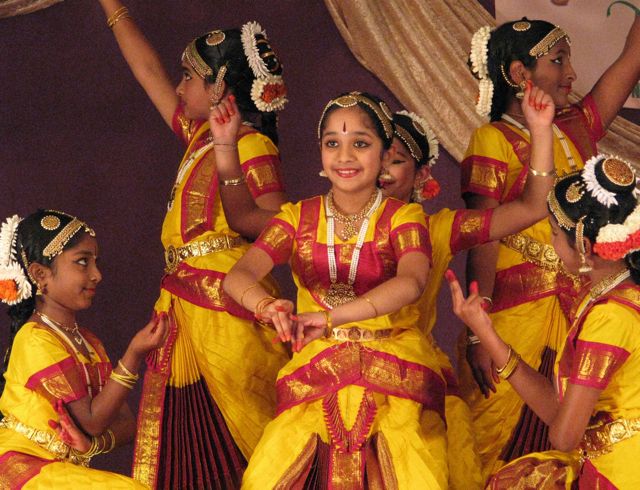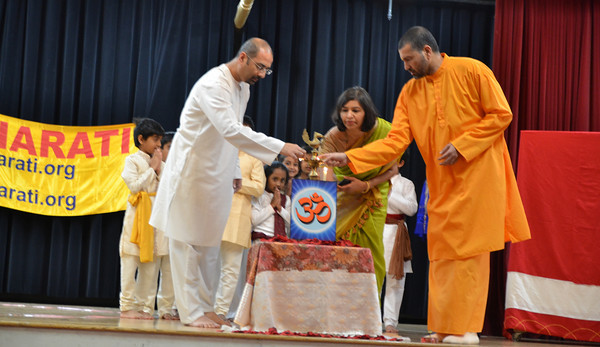About 60 volunteers and YIC 2011 batch students with their families went to Shivanand Ashram, Grass Valley, near Sacramento from July 2nd to 4th 2011. It was a two day retreat where the participants got an experience of Ashram’s daily life that consisted of morning meditation, bhajans, satsang, morning and evening yogasana classes, arati and prasad offering. Ashram’s satvic vegan meals at 10am and 6pm were wholesome, healthy, complete and soul filling. Apart from Ashram’s activities, Yoga Bharati organized satsang and discussions between noon and 4pm. Shree N.V.Raghuram, the spiritual founder of Yoga Bharati conducted the satsangs and discussions. The ambience of the Ashram, the friendly, hospitable and accommodative Ashram staff and management, and Raghuramji’s wisdom filled talks were a great elixir for the inner quest and curiosity of the retreat attendees. Most of all, the purity and authenticity of Vedantic tradition in the ashram and the simplicity and spiritual ferver of the ashramites was the highlight of the retreat experience. Many retreat attendees said that it was like visiting ancient India with all its glory.
The retreat began on Saturday morning with check-in and brunch. After this, we all met in the main yoga hall (Bhrama-Jiignasu mandir) which was a beautiful room with a pedestal on which Dakshinamurthy was placed in the center, the murty’s of Swami Shivananda and Swami Vishnudevananda on either side and Shankaracharya’s pratima to the side blessing us all. The very appearance of this setting set the retreat attendees at peace and we were all ready to begin the satsang. Swami Sitaramananda, Director and the spiritual head of Shivananda Ashram welcomed us all and a wonderful introduction of the lineage of Swami Shivananda right from Sankaracharya to Vishudevananda was explained. Raghuramji talked about how he had met Swami Vishnudevananda when he was a teenager. Raghuramji then gave us all a wonderful discourse on the topic of “Yagna”. He explained how yagna always took place in creation from time immemorial. He said that many refer to yagna as a ‘sacrifice’, but yagna is more than that. Every seed has a tree in it. Only when the seed gives up his seed-ness would a seed become a tree. So yagna in essence is nothing but the constant transformation and change that happens in the creation. The food that we eat becomes energy and hence it is also yagna – said Raghuramji. He explained the meaning of ”brahmarpanam brahmahavihi”. He talked about four types of yagnas mentioned in Bhagavad Gita – dravya yagna, tapo yagna, swadhyaya yagna and Jnana yagna. He also explained the significance of ghee put in the yagna. Cow’s milk signifies satva. Curdling of milk represents the paradigm shift from the materialistic thinking to the spiritual thinking of a seeker. Churning of the yogurt represents the constant nidhi-dhyasana or spiritual churning that we must do. The result of this churning is the butter which represents spiritual knowledge. When this is further purified and ego is removed with the fire of sadhana, ghee results – pure Jnana without any ego. When any task is thus done without ego, it becomes yagna.
The talk was followed by a discussion on our respective Karma Yoga. People talked about what was their spiritual experience was, after completing the yoga course and what is the karma yoga that they all want to be part of, in their sadhana, and in contributing to spreading the message of yoga.
The evening session was specially wonderful as we had a great bhajan concert by a local group of singers from Sacred Caravan group. They sang bhajans with their wonderful instruments - flute, 12 string guitar, harp, tabla and other instruments. Their professional performance, their beautiful voices and their devotional and passionate rendering of the songs was enchanting. They sang bhajans on Ganesha, Shiva, Krishna, Rama, Hanuman and Gandhiji’s Raghupati Raghava song. They also performed some wonderful solo Hindustani instrumental pieces and a great rendering of an instrumental piece on Harp. The audience was mesmerized.
On Sunday morning Swami Sitaramananada conducted meditation, bhajans, and then talked beautifully on Prana, Pancha Bhutas, the way to channelize prana and how to live life so that our pranic body is in good health, etc. We had a satvic brunch and then we all set out to a small hike to Durga Mandir. The small and yet neatly constructed temple, the beautiful pratima of Durga in the sactum sanctorum, the cool and shady veranda outside the temple, the flora and fauna around the temple, a little bubbly pond and a white marble shivalinga at the center of the pond created our moods for a bhajan session. We sat at the veranda in a circle and sang Devi bhajans followed by a song from Supriya on Tyagaraja composition, Shiva bhajan by Ankita and Gayatri Mantra song by Vedant and Shushant sung in a classical style. Raghuramji explained how Tyagaraja attained the first advaita state (Nirvikalpa Samadhi) and how he sang the song after coming back from the advaita Samadhi where he sung a song that said, he missed mother Sita, Rama and Lakshmanna in that advaita state and was glad to be back to the normal dualistic world. This gives Dvaita state as much grandeur as Advaita in Indian philosophy. Raghuramji answered the question on whether one can deviate from the traditional chanting style and said that it was okay to sing it in other ways and enjoy, although all the benefits stated in the Vedas may not be obtained when the rules of Vedas such as udatta, anudatta, sarita, etc are not followed. With many such discussions on various topics, no one wanted to leave the temple, but we had to disperse eventually.
We met in the Brahma-jignasu hall again and then after a refreshing drink of lemonade and orange juice prepared by Yoga Bharati volunteers, and a wonderful deep relaxation by Yogi Mahendra, we all moved into a question and answer session. One of the questions was about chanting of A-U-M versus OM and when are we allowed to break into Akara, Ukara and Mkara and when should we not do so. Another set of questions was about who is Ekanath Ranade, how was Vivekananda Rock Memorial and Vivekananda Yoga Movement began. Yet another topic was about ‘What is the meaning of false belief?’, ‘Is there is such a thing as false belief?’, ‘Being a seeker for Self is a selfish act?’, ‘Shreyas and Preyas mentioned in Kathopanishad’, etc. Raghuramji addressed each of the questions in his own elegant manner where his answers were logical, rational and scientific and satisfying to both a rebel inside the seekers as well as to the already surrendered seekers. No one left the hall without getting their questions answered.
On Sunday evening, there was a beautiful bhajan session followed by satsang by Swami Swaroopananda who is the head of Shivananda Ashram in Bahamas and Israel and was visiting the ashram. He answered some of the questions such as – ‘Can we change the world?’, ‘Is there such a thing as good and bad?’, ‘Why do we have fear’?, ‘Should we be good to people who are bad to us?’, etc. Swamiji answered every question elegantly and satisfyingly with references to Vedanta, Sankaracharya’s philosophy, Bhagavad Gita quotes and with references to Swami Shivananda and Vishudevandanda’s teachings. To the question “Can we change the world?”, he beautifully explained that we cannot change the world, but only change ourselves. He said however, we can never give the world what we don’t have, so we need to make an effort to have good values and then share with the world what we have and that makes the world a better place. He referred to Swami Shivananda’s teaching to “be good and do good”. To the question “Is there such a thing and good and bad?”, he cleverly understood the intent of Advaita student where Advaita is beyond all of the duality and said that in the dualistic world we live, there is something called dharma and adharma. He said ‘there is such a thing as the right way to fly an airplane and a wrong way’ and said that we should attempt to follow the path of dharma. He said that only to the yogi who has transcended the universe, there is no duality and only then he can be beyond good and bad. To the question “Should we be good to those who are bad to us?”, he referred to Hindu Karma theory and said when someone is bad to us, we should think that it is perhaps because we have inflicted bad to others in our past lives. So the smart thing to do would be to do good to others now, so that they will be good to us later. To the question about fear, he beautifully explained how fear in inevitable in dualistic world and until and unless we realize the inherent non-dual reality, we all have to face fear.
We ended the retreat on Monday morning after the Ashram’s morning activity where Swami Sitaramananda explained the workings of the mind, its distractions, how to control the mind, and how japa, tapa, yogasanas, etc help us come out of the distractions and help us realize ourselves. After the brunch, we had a photo session with Swami Sitaramananda and a concluding program (see below for picture). She read some of the poems that she had written about Swami Vishnudevananda and then blessed us all. She was happy to see a large Indian group visiting the ashram which she said rarely happens. She asked us to visit regularly. She also gave some books as souvenirs for Yoga Bharati. Raghuramji and Swami Sitaramananda exchanged good words before concluding. Little Ankita sang Bhagavad Gita shlokas in front of Swami Sitarananda that made everyone ecstatic with joy. All the kids had a great time and did not want to leave the ashram.
We got a deep experience of Karma Yoga where Yoga Bharati folks took turns to help in the kitchen and cleaning of dishes, we experienced Raja Yoga with excellent asana classes, we experienced Bhakti in the meditation, bhajans and aarati and Prasad, and we experienced Jnana yoga with all the satsangs we attended by Swami Sitaramananda, Swami Swaroopananda and Raghuramji. It was a spiritual retreat indeed!






